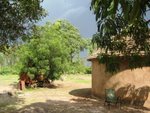What a crazy couple of weeks it's been! I just got back to Ségou after traveling to Dakar, Senegal for the West African International Sorftball Tournament (WAIST). I'll write up a separate blog for my vacation and the tournament (I have TONS of pictures to post, too), but I must dedicate a separate entry strictly to Malian transport.
I had a few options to get to Dakar. Plane, train (I wish automobile, but sadly that one wasn't an option) or bus. Planes are too expensive, and I've heard too many horror stories about the train, so I opted to take the bus along with about 20 other PCVs. The longest bus ride I'd ever endured was a six-hour ride from Sikasso to Ségou -- which was uncomfortable, but tolerable. I thought I could handle the long ride to Dakar just fine.
Let me first describe the typical Malian bus. Picture a Greyhound (or a city bus in some cases) built in the 1970s that is so ghetto people refuse to ride in it. Tack on 30 years of hard use, and that's the kind of bus that serves as a classy form Malian transport. Air conditioning is non-existent -- you're lucky if the windows open. Traveling with livestock? No problem! They'll hog-tie your sheep and goats and throw them under the bus along with the luggage. Or they'll strap your baggage to the roof of the bus. They overfill the busses, so the last people to buy tickets have to sit on stools which are placed in the aisle (luckily this hasn't been me!). They usually ride with the door open to get some air flow. Otherwise, you sit on a stinky, spongy seat marveling at just how much sweat you can produce while sitting and doing nothing. The downside to having good air flow, however, is the dust. Bring your turbans and hankerchiefs, or else suffer the consequences of bloody noses and soar throats. But I digress...
We left Bamako for Kayes (in western Mali) on Tuesday, Feb.13. We showed up at the bus station at 9am to catch our 10:30 bus. To our surprise, our bus had already left without us (it WAS a surprise, too, since busses usually run a couple hours late). Luckily, an extremely nice and helpful employee reimbursed our tickets and found us another bus across the city that was leaving at 10:30. The bus was small (see pic), but we had faith it would get us to Kayes, where we were scheduled to meet the rest of our group and continue to Dakar.
I first got the hunch that something wasn't normal when we pulled off the road -- after driving 4 blocks -- and the driver jumped out to look under the hood. After 45 minutes, we continued driving. We also continued stopping about every 20-30 minutes for the driver to hop out and open the hood. At one point we stopped, and the driver ran out to a puddle in a field to fill up a jug of water. It was then that we realized our frequent stops were for the driver to pour water into the radiator. During one stop, Yuri got out to observe. He came back to report that, after filling the radiator with water, he then poured water all over the engine to cool it down, and then he crumpled up a whole pack of cigarettes and added that to the radiator fluid -- I mean water. Kids, don't try this at home -- these are professionals!!
Nighttime slowly came as we crawled toward the Kayes boundary. When we did finally reach the gendarms stop (around midnight); we waited on the bus for over 30 minutes. Finally, we were told that we couldn't continue until daylight, due to bandits lurking in the shadows beyond. So we climbed off the bus, set up mosquito tents (thank goodness we had those!), and slept on the road -- literally. Well, I actually didn't sleep -- I shivered my way through the night, because my fleece was packed on top of the bus. The desert gets cold at night!

(where we slept next to the bus)
We finally got moving again at about 6am, and made it to Kayes city by 11. I am told that, normally, a bus ride from Bamako to Kayes takes 9-12 hours. It took us over 24!
I won't go into detail about the rest of the voyage -- it would rival The Odyssey! But I'll just say that it took another 24 hours to get from Kayes to Dakar (it should've only taken 12 as well). And the trip back home was just as unenjoyable -- complete with a bus that served as a breeding ground for mosquitos (I killed over 30 before giving up the battle), drivers demanding we pay them money to bribe the police and gendarms, spending another night trapped at the Kayes border, etc.
Maybe next time I'll take my chances with the train...











